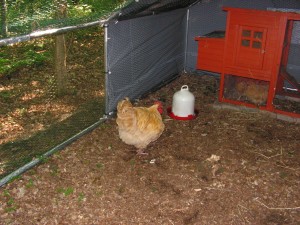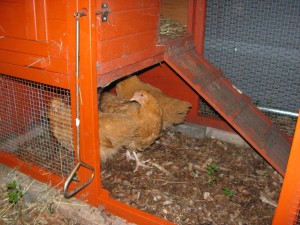Made some progress on the chickens this week and went to have a look at some of the options available at a few farms. The Rhode Island Reds were pretty much a given as they seem to come recommended by everyone and crossed with Marans give the famous Warrens. Not that I have any Marans but the option is there for the third cage. So I bought five Rhode Island Reds, Four hens and one cock. They are still young yet so am keeping them in the back garden close to home for a few more weeks.
I spoke to someone on the Brahmas and they recommended them for meat as well but confirmed what some of you had said about their feet and that they recommended Buff Orpington’s. Side by side there was little differences between the two and both were very similar but I did like the look of the Buff Orpington. The cock that was there was one year old and a very impressive beast he was too. Still a chicken though as he run like a girl to escape getting captured.
So I bought four Buff Orpington’s. Three Hens and one cock. These are a bit older than the Rhode Island Reds and were able to go straight into the cage.
Both sets are currently doing well and no sign of any animal attacks at either. Foxes at the land and local cats at home.
Next up is moving the IBCs and the roof panels up to the land and freeing space on my path.
Still looking for a reasonably priced JCB. May have to raise my expectations on what I need to spend though.


None of them have died then – that’s a relief.
Not yet but give them time. That pesky fox is out there.
next time your replacing your chucks, think about hatching eggs. it really easy easy and straightforward, this time of year is perfect, the chicks only need 3 weeks on the lamp and then they’re released into the chicken run.
The two breeds that I favour are Cornish for meat birds and Warren hybrids for eggs. Cornish grow fast and heavy while warrens will give you an egg a day for the first year.
My birds all free range apart from when I’m away, then they’re confined with a feed hopper and a drinker.
Usually they’re safe enough if I make sure that they’re shut in before dusk. (I have had only two losses to foxes and one to a polecat in the last ten years.) Their brood box is inside a large 10g 2″X1″ mesh cage which measures 4mx8m set on a timber fram of 2″x4″ tanilised and rough sawn. This has a complete steel roof. To prevent digging predators the bottom of the mesh has a 12″ flange folded out flat to the ground. This whole pen is sited on a base of “crusher-run” which has ground oyster shell on top for the birds to scratch in and pick wheat from to stop them getting bored.